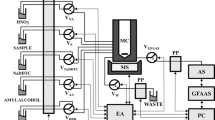Abstract
A fully automated pretreatment system based on sequential injection solid-phase extraction (SPE) coupled to a graphite furnace atomic absorption spectrometer (Auto-Pret-GFAAS system) was developed to determine trace amounts of cadmium and lead. A handmade minicolumn packed with a chelating resin was used for the preconcentration of both metals. All protocol for the on-line SPE method was controlled by home-made software. A trigger switch that was placed next to the graphite furnace was used to synchronize the home-made software with built-in software in the GFAAS. One milliliter of sample solution was flowed through into the minicolumn, the analytes were collected and concentrated on the solid phase, and the analytes were eluted with nitric acid (3 M), and detected by GFAAS. The limits of detection (3σ) for cadmium and lead were 0.20 and 2.6 ng L−1, respectively. The sample throughput was 47 h−1 for 1 mL sample loading. The proposed sensitive method with the original Auto-Pret-GFAAS system was applied to the determination of cadmium and lead in tap water and in leached solutions from ceramic ware using 4% acetic acid.
Similar content being viewed by others
References
S. Olsen, L. R. Pessenda, J. Ruzicka, and E. H. Hansen, Analyst, 1983, 108, 905.
M. Trojanowics, “Flow injection analysis—Instrumentation and applications”, 2000, World Scientific.
S. D. Kolev and I. D. McKelvie, “Advances inflow injection analysis and related techniques”, 2008, Elsevier.
T. Yamane, M. Izawa, and S. Osada, Bull. Soc. Sea Water Sci. Jpn., 2006, 60, 352.
T. Yamane, Y. Kouzuka, and M. Hirokawa, Talanta, 2001, 55, 387.
Y. Narusawa, Anal. Chim. Acta, 1988, 204, 53.
K. Grudpan, N. Warakijcharoenchai, O. Tue-Ngeun, P. Sooksamiti, and J. Jakmunee, ScienceAsia, 1999, 25, 99.
T. Yamane and Y. Yamaguchi, Anal. Chim. Acta, 1997, 345, 139.
T. Seki, H. Takigawa, Y. Hirano, Y. Ishibashi, and K. Oguma, Anal. Sci., 2000, 16, 513.
Y. Bakircioglu, S. R. Segade, E. R. Yourd, and J. F. Tyson, Anal. Chim. Acta, 2003, 485, 9.
G. A. Zachariadis, A. N. Anthemidis, P. G. Bettas, and J. A. Stratis, Talanta, 2002, 57, 919.
S. Dadfarnia, I. Green, and C. W. McLeod, Anal. Proc. Incl. Anal. Commun., 1994, 31, 61.
Z. Sperling, X. Yin, and B. Welz, J. Anal. At. Spectrom., 1991, 6, 295.
Y. Hirano, J. Nakajima, K. Oguma, and Y. Terui, Anal. Sci., 2001, 17, 1073.
J. Nakajima, Y. Hirano, and K. Oguma, Anal. Sci., 2003, 19, 585.
J. Ruzicka and G. D. Marshall, Anal. Chim. Acta, 1990, 237, 239.
J. Wang and E. H. Hansen, TrAC, Trends Anal. Chem., 2003, 22, 836.
A. Economou, TrAC, Trends Anal. Chem., 2005, 24, 416.
P. Ampan, J. Ruzicka, R. Atallah, G. D. Christian, J. Jakmunee, and K. Grudpan, Anal. Chim. Acta, 2003, 499, 167.
X. Long, M. Miró, and E. H. Hansen, Anal. Chem., 2005, 77, 6032.
S. C. Hight, J. AOAC Int., 2000, 83, 1174.
S. C. Hight, J. AOAC Int., 2001, 84, 861.
M. Kuramochi, K. Tomioka, M. Fujinami, and K. Oguma, Talanta, 2005, 68, 287.
A. Sabarudin, N. Lenghor, Y. Liping, Y. Furusho, and S. Motomizu, Spectrosc. Lett., 2006, 39, 669.
R. K. Katarina, N. Lenghor, and S. Motomizu, Anal. Sci., 2007, 23, 343.
H. Sakamoto, K. Yamamoto, T. Shirasaki, and Y. Inoue, Bunseki Kagaku, 2006, 55, 133.
Commentary on JIS S 2400, “Heat resistant ceramic tablewares”, 2000, Japanese Industrial Standards Committee, Tokyo.
Author information
Authors and Affiliations
Corresponding author
Rights and permissions
About this article
Cite this article
Ueda, M., Teshima, N., Sakai, T. et al. Highly Sensitive Determination of Cadmium and Lead in Leached Solutions from Ceramic Ware by Graphite Furnace Atomic Absorption Spectrometry Coupled with Sequential Injection-based Solid Phase Extraction Method. ANAL. SCI. 26, 597–602 (2010). https://doi.org/10.2116/analsci.26.597
Received:
Accepted:
Published:
Issue Date:
DOI: https://doi.org/10.2116/analsci.26.597




